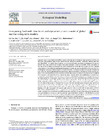Comparing food web structures and dynamics across a suite of global marine ecosystem models
dc.contributor.author
Sailley, Sévrine F.
dc.contributor.author
Vogt, Meike
dc.contributor.author
Doney, Scott C.
dc.contributor.author
Aita, Maki Noguchi
dc.contributor.author
Bopp, Laurent
dc.contributor.author
Buitenhuis, Erik Theodoor
dc.contributor.author
Hashioka, Taketo
dc.contributor.author
Lima, Ivan D.
dc.contributor.author
Le Quéré, Corinne
dc.contributor.author
Yamanaka, Yasuhiro
dc.date.accessioned
2023-06-14T13:36:42Z
dc.date.available
2017-06-10T23:32:09Z
dc.date.available
2023-06-14T13:36:42Z
dc.date.issued
2013-07-24
dc.identifier.issn
0304-3800
dc.identifier.issn
1872-7026
dc.identifier.issn
0167-8892
dc.identifier.other
10.1016/j.ecolmodel.2013.04.006
en_US
dc.identifier.uri
http://hdl.handle.net/20.500.11850/74077
dc.identifier.doi
10.3929/ethz-b-000074077
dc.description.abstract
Dynamic Green Ocean Models (DGOMs) include different sets of Plankton Functional Types (PFTs) and equations, thus different interactions and food webs. Using four DGOMs (CCSM-BEC, PISCES, NEMURO and PlankTOM5) we explore how predator–prey interactions influence food web dynamics. Using each model's equations and biomass output, interaction strengths (direct and specific) were calculated and the role of zooplankton in modeled food webs examined. In CCSM-BEC the single size-class adaptive zooplankton preys on different phytoplankton groups according to prey availability and food preferences, resulting in a strong top-down control. In PISCES the micro- and meso-zooplankton groups compete for food resources, grazing phytoplankton depending on their availability in a mixture of bottom-up and top-down control. In NEMURO macrozooplankton controls the biomass of other zooplankton PFTs and defines the structure of the food web with a strong top-down control within the zooplankton. In PlankTOM5, competition and predation between micro- and meso-zooplankton along with strong preferences for nanophytoplankton and diatoms, respectively, leads to their mutual exclusion with a mixture of bottom-up and top-down control of the plankton community composition. In each model, the grazing pressure of the zooplankton PFTs and the way it is exerted on their preys may result in the food web dynamics and structure of the model to diverge from the one that was intended when designing the model. Our approach shows that the food web dynamics, in particular the strength of the predator–prey interactions, are driven by the choice of parameters and more specifically the food preferences. Consequently, our findings stress the importance of equation and parameter choice as they define interactions between PFTs and overall food web dynamics (competition, bottom-up or top-down effects). Also, the differences in the simulated food-webs between different models highlight the gap of knowledge for zooplankton rates and predator–prey interactions. In particular, concerted effort is needed to identify the key growth and loss parameters and interactions and quantify them with targeted laboratory experiments in order to bring our understanding of zooplankton at a similar level to phytoplankton.
en_US
dc.format
application/pdf
en_US
dc.language.iso
en
en_US
dc.publisher
Elsevier
en_US
dc.rights.uri
http://creativecommons.org/licenses/by/3.0/
dc.subject
Dynamic green ocean model
en_US
dc.subject
Plankton functional types
en_US
dc.subject
Zooplankton
en_US
dc.subject
Food web dynamic
en_US
dc.subject
Predatoprey interactions
en_US
dc.title
Comparing food web structures and dynamics across a suite of global marine ecosystem models
en_US
dc.type
Journal Article
dc.rights.license
Creative Commons Attribution 3.0 Unported
dc.date.published
2013-05-16
ethz.journal.title
Ecological Modelling
ethz.journal.volume
261-262
en_US
ethz.journal.abbreviated
Ecol. Model.
ethz.pages.start
43
en_US
ethz.pages.end
57
en_US
ethz.version.deposit
publishedVersion
en_US
ethz.identifier.nebis
000023941
ethz.publication.place
Amsterdam
en_US
ethz.publication.status
published
en_US
ethz.leitzahl
ETH Zürich::00002 - ETH Zürich::00012 - Lehre und Forschung::00007 - Departemente::02350 - Dep. Umweltsystemwissenschaften / Dep. of Environmental Systems Science::02721 - Inst. f. Biogeochemie u. Schadstoffdyn. / Inst. Biogeochem. and Pollutant Dynamics::03731 - Gruber, Nicolas / Gruber, Nicolas
en_US
ethz.leitzahl.certified
ETH Zürich::00002 - ETH Zürich::00012 - Lehre und Forschung::00007 - Departemente::02350 - Dep. Umweltsystemwissenschaften / Dep. of Environmental Systems Science::02721 - Inst. f. Biogeochemie u. Schadstoffdyn. / Inst. Biogeochem. and Pollutant Dynamics::03731 - Gruber, Nicolas / Gruber, Nicolas
ethz.date.deposited
2017-06-10T23:35:08Z
ethz.source
ECIT
ethz.identifier.importid
imp59365129149b287529
ethz.ecitpid
pub:117183
ethz.eth
yes
en_US
ethz.availability
Open access
en_US
ethz.rosetta.installDate
2017-07-14T14:16:43Z
ethz.rosetta.lastUpdated
2024-02-03T00:07:01Z
ethz.rosetta.versionExported
true
ethz.COinS
ctx_ver=Z39.88-2004&rft_val_fmt=info:ofi/fmt:kev:mtx:journal&rft.atitle=Comparing%20food%20web%20structures%20and%20dynamics%20across%20a%20suite%20of%20global%20marine%20ecosystem%20models&rft.jtitle=Ecological%20Modelling&rft.date=2013-07-24&rft.volume=261-262&rft.spage=43&rft.epage=57&rft.issn=0304-3800&1872-7026&0167-8892&rft.au=Sailley,%20S%C3%A9vrine%20F.&Vogt,%20Meike&Doney,%20Scott%20C.&Aita,%20Maki%20Noguchi&Bopp,%20Laurent&rft.genre=article&rft_id=info:doi/10.1016/j.ecolmodel.2013.04.006&
Files in this item
Publication type
-
Journal Article [128813]

